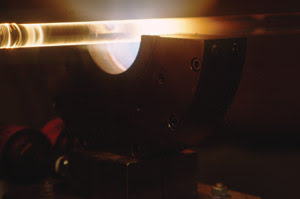Gold- and aluminum-buffered fibers are resistant to gases, to radiation and to other hostile environments in a range of applications.
Konrad Lisi, Fiberguide Industries
Glass optical fibers typically are manufactured with a polymer buffer or coating that protects the glass from scratches that would severely reduce the inherent strength of the fiber. Polymer coatings have been used for more than 25 years in the telecommunications and specialty fiber optic markets. However, some specialty fiber optic applications require a fiber that can operate in an environment that would damage or destroy the polymer coating. For example, high temperatures, acidic chemicals and high mechanical stress can damage the fiber coating severely and cause a catastrophic failure if the fiber breaks.
Typical polymer coatings operate at a maximum temperature of 125 °C, but typical applications in a severe environment can have temperature requirements up to 700 °C. Polymers are dissolved by many acids, and when a fiber with a polymer coating is subjected continuously to a tensile stress, it will break because the coating allows atmospheric moisture to penetrate and attack the fiber surface.
These environmental attacks can be eliminated by coating the fiber with either gold or aluminum (Figure 1). For example, aluminum-coated fibers can withstand temperatures between –269 and 400 °C and gold-coated fibers between –269 and 700 °C. When fibers with metal coatings are placed under high tensile stress, they do not allow moisture to diffuse through the coating and attack the fiber surface because the coating creates a hermetic seal.

Figure 1. These cross sections show a gold-coated fiber (a) and an aluminum-coated fiber (b).
Typical applications that require metal coatings include oil exploration, oil/gas burner (furnaces) monitoring, nuclear power plant monitoring, etc. In oil exploration, a fiber with a sensor is lowered into a deep hole with hot water. The hot water can be corrosive, as can the oil, acids and other chemicals in the hole. In oil/gas burners, the fiber is inserted directly into, or very near to, the flame. Flame temperatures exceed the maximum that polymer coatings can survive, but gold fibers can withstand such temperatures. Spectral analysis of the flame allows the control of parameters that can increase efficiency and, therefore, lower fuel cost.
In processing strongly acidic exotic chemicals, monitors are used to determine whether the chemicals are mixing correctly. Because polymer-coated fibers do not hold up well in this application, gold-coated fibers are recommended. As determined by nuclear radiation monitoring in power plants, when fibers are heated to 400 °C, aluminum coatings can reduce nuclear radiation damage to the fibers by a factor of 100.

Figure 2. The preform is the starting material from which all fibers are made. Here it is shown mounted on an electronically controlled lathe for cleaning.Figure 1. These cross sections show a gold-coated fiber (a) and an aluminum-coated fiber (b).
Aluminum and gold coatings can be applied to a wide variety of step index multimode, graded-index and single-mode fibers. However, coating metals is not without specific challenges. To coat aluminum, the coating crucible must be kept oxygen-free because aluminum oxidizes readily.
Temperature controls and specific temperature settings are critical for both gold and aluminum coatings. The gold-coating process requires an extremely high temperature of ~1100 °C. Such high temperatures require special nonmetallic crucibles and handling tools, and strict temperature controls.
Meet the author
Konrad Lisi is director of marketing and sales at Fiberguide Industries in Stirling, N.J.; e-mail: [email protected].